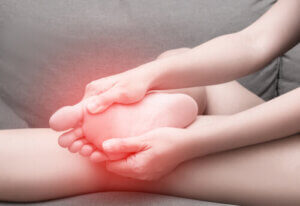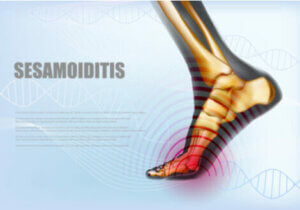How to Treat Sesamoiditis Pain

If you’ve recently started walking more or on more complex surfaces and have foot pain, it might be sesamoiditis. It’s a condition that occurs in a sensitive area on the sole of the foot, which can also affect your daily habits. Learn all about sesamoiditis pain in this article.
What is sesamoiditis?
Here, we’re talking about an –itis, which means it’s a condition that causes inflammation. This specific condition refers to the sesamoid bones. However, it’s technically not the bone that becomes inflamed, but the structures around it.
Despite the fact that there are more bones similar to these in the human body, with this injury, we’re usually talking about the two small, rounded bones that are located just behind the big toe. In some cases, the bones may be “split” which makes it look as if you have four, but this is rare.
These bones protect the tendons of different muscles that run along the sole of the foot. Also, they have a lever function to help muscles perform more effectively.
Being on the sole of the foot, these bones have to withstand strong pressure. When walking, running, jumping or anything where you put your feet on the ground, these little bones will absorb part of the force.
Causes of sesamoiditis pain
The causes of sesamoiditis pain are related to the fact that this area has to bear significant loads.
- Repeated stress. If you walk long distances, are a long-distance runner, or play basketball, it’s common for the forces to build up and produce sesamoiditis.
- A sudden increase in strength. As in many other conditions, not gradually increasing exercise can be harmful. If you go from a sedentary life to complex hiking routes, neither the muscles nor the soft tissues will be prepared. In fact, one of the consequences may be that the sesamoid bones suffer.

- Incorrect movement. Here, we’re talking about two factors. On one hand, if you do sports activities incorrectly, you’re putting more pressure on the area, or at least pressure the human body isn’t prepared to withstand. Second, if you have a flat or cavus foot, the distribution of weight will also be incorrect and may lead to sesamoiditis. Also, this applies if you wear high heels, which puts more pressure on the ball of the foot.
- Infections. Bones and their surrounding structures can also become inflamed due to infection.
- Degenerative processes such as osteoarthritis or other arthropathies.
How to treat sesamoiditis pain
The main symptom of sesamoiditis is pain and stiffness in the sole of the foot and behind the big toe. In addition, since there’s inflammation, the area will be swollen, red, and warm to the touch. Also, a person suffering from sesamoiditis pain will change how they walk to try and support the painful area as little as possible.
It can be a long process to eliminate this pain. In fact, it could take up to six months in certain situations, since in serious cases there might be a bone fracture.
The main component of recovery is rest. Stop putting pressure on it to give yourself the best possibility of recovering.
Second, you need to analyze your case: know if you have any genetic modification that makes you prone to this type of injury, or if you can improve your sports movements of equipment.
Also, you need to treat inflammation with the classic methods, applying ice, elevating, and compressing the area. If necessary, you can take anti-inflammatory medication as well.

Besides this, it’s also a good idea to visit a physical therapist. A professional in this field can help you to treat the pain and recover using techniques such as electrical currents and ultrasounds.
Likewise, he can also help you by recommending wraps or splints to help support your foot. Finally, he can also give you personal advice depending on your lifestyle to prevent it from happening again.
In conclusion, we must emphasize that, although there are surgical options available, they’re rare. Conservative treatment will always be the first option.
If you’ve recently started walking more or on more complex surfaces and have foot pain, it might be sesamoiditis. It’s a condition that occurs in a sensitive area on the sole of the foot, which can also affect your daily habits. Learn all about sesamoiditis pain in this article.
What is sesamoiditis?
Here, we’re talking about an –itis, which means it’s a condition that causes inflammation. This specific condition refers to the sesamoid bones. However, it’s technically not the bone that becomes inflamed, but the structures around it.
Despite the fact that there are more bones similar to these in the human body, with this injury, we’re usually talking about the two small, rounded bones that are located just behind the big toe. In some cases, the bones may be “split” which makes it look as if you have four, but this is rare.
These bones protect the tendons of different muscles that run along the sole of the foot. Also, they have a lever function to help muscles perform more effectively.
Being on the sole of the foot, these bones have to withstand strong pressure. When walking, running, jumping or anything where you put your feet on the ground, these little bones will absorb part of the force.
Causes of sesamoiditis pain
The causes of sesamoiditis pain are related to the fact that this area has to bear significant loads.
- Repeated stress. If you walk long distances, are a long-distance runner, or play basketball, it’s common for the forces to build up and produce sesamoiditis.
- A sudden increase in strength. As in many other conditions, not gradually increasing exercise can be harmful. If you go from a sedentary life to complex hiking routes, neither the muscles nor the soft tissues will be prepared. In fact, one of the consequences may be that the sesamoid bones suffer.

- Incorrect movement. Here, we’re talking about two factors. On one hand, if you do sports activities incorrectly, you’re putting more pressure on the area, or at least pressure the human body isn’t prepared to withstand. Second, if you have a flat or cavus foot, the distribution of weight will also be incorrect and may lead to sesamoiditis. Also, this applies if you wear high heels, which puts more pressure on the ball of the foot.
- Infections. Bones and their surrounding structures can also become inflamed due to infection.
- Degenerative processes such as osteoarthritis or other arthropathies.
How to treat sesamoiditis pain
The main symptom of sesamoiditis is pain and stiffness in the sole of the foot and behind the big toe. In addition, since there’s inflammation, the area will be swollen, red, and warm to the touch. Also, a person suffering from sesamoiditis pain will change how they walk to try and support the painful area as little as possible.
It can be a long process to eliminate this pain. In fact, it could take up to six months in certain situations, since in serious cases there might be a bone fracture.
The main component of recovery is rest. Stop putting pressure on it to give yourself the best possibility of recovering.
Second, you need to analyze your case: know if you have any genetic modification that makes you prone to this type of injury, or if you can improve your sports movements of equipment.
Also, you need to treat inflammation with the classic methods, applying ice, elevating, and compressing the area. If necessary, you can take anti-inflammatory medication as well.

Besides this, it’s also a good idea to visit a physical therapist. A professional in this field can help you to treat the pain and recover using techniques such as electrical currents and ultrasounds.
Likewise, he can also help you by recommending wraps or splints to help support your foot. Finally, he can also give you personal advice depending on your lifestyle to prevent it from happening again.
In conclusion, we must emphasize that, although there are surgical options available, they’re rare. Conservative treatment will always be the first option.
All cited sources were thoroughly reviewed by our team to ensure their quality, reliability, currency, and validity. The bibliography of this article was considered reliable and of academic or scientific accuracy.
- Turf toe and sesamoiditis: what the radiologist needs to know. Schein A., Skalski M., Patel B., et al. Clinical Imaging. Vol. 39, Issue 3 (2015); 380-389
- Tratamientos de la sesamoiditis: físicos, ortésicos y quirúgicos. Revisión bibliográfica. González Piñeiro, A. Trabajo fin de grado. Universidade da Coruña. Facultade de Enfermaría e Podoloxía (2015)
- A radiological study of anatomical variants of hallux sesamoids. Mallikarjun A., Muthiah P., Bhuvaneswari V. National Journal of Clinical Anatomy. 7 (03): 128-133 (2018)
This text is provided for informational purposes only and does not replace consultation with a professional. If in doubt, consult your specialist.








